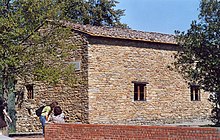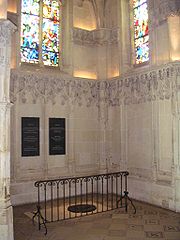| Leonardo da Vinci | |
|---|---|
| Birth name | Leonardo di Ser Piero da Vinci |
| Born | April 15, 1452 Vinci, Tuscany, Italy |
| Died | May 2, 1519 (aged 67) Amboise, Indre-et-Loire, France |
| Nationality | Italian |
| Field | Many and diverse fields of arts andsciences |
| Movement | High Renaissance |
| Works | Mona Lisa, The Last Supper, The Vitruvian Man |
The personal life of Leonardo da Vinci (April 15, 1452 – May 2, 1519) has been a subject that has excited interest, enquiry and speculation since within a few years of his death. Leonardo has long been regarded as the archetypal Renaissance Man, described by the Renaissance biographer Giorgio Vasari as having qualities that “transcended nature” and being “marvellously endowed with beauty, grace and talent in abundance”. Interest in and curiosity about Leonardo has continued unabated for five hundred years. Modern descriptions and analysis of Leonardo’s character, personal desires and intimate behavior have been based upon various sources: records concerning him, his biographies, his own written journals, his paintings, his drawings, his associates and commentaries that were made concerning him by contemporaries.
Biography
Leonardo’s childhood home in Anchiano.
Leonardo was born on April 15, 1452, “at the third hour of the night” in the Tuscan hill town of Vinci, in the lower valley of the Arno Riverin the territory of the Republic of Florence. He was the out-of-wedlock son of the wealthy Messer Piero Fruosino di Antonio da Vinci, a Florentine legal notary, and Caterina, a peasant. His full birth name was “Lionardo di ser Piero da Vinci”, meaning “Leonardo, (son) of (Mes)ser Piero from Vinci”. The inclusion of the title “ser” indicated that Leonardo’s father was a gentleman.
Leonardo spent his first five years in the hamlet of Anchiano in the home of his mother, then from 1457 lived in the household of his father, grandparents and uncle, Francesco, in the small town of Vinci. His father had married a sixteen-year-old girl named Albiera, Ser Piero married four times and produced children by his two later marriages. Leonardo’s seven brothers were later to argue with him over the distribution of his father’s estate.
Burial of Leonardo da Vinci, in the Chapel of Saint-Hubert, Château d’Amboise, France.
At the age of about fourteen Leonardo was apprenticed by his father to the artist Andrea del Verrocchio. Leonardo was eventually to become a paid employee of Verrocchio’s studio. During his time there, Leonardo met many of the most important artists to work in Florence in the late fifteenth century including Botticelli, Domenico Ghirlandaio andPietro Perugino. Leonardo helped Verrocchio paint The Baptism of Christ, completed around 1475. According to Vasari, Verrocchio, on seeing the beauty of the angel that his young pupil had painted, never painted again.
Florence was at this time a republic, but the city was increasingly under the influence of a single powerful family, the Medici. Lorenzo de’ Medici, who came to be known as “Lorenzo the Magnificent”. In 1481 Leonardo commenced an important commission, the painting of a large altarpiece for the church of S. Donato a Scopeto. The work was never completed. Leonardo left Florence and travelled to Milan carrying a gift from Lorenzo to the regent ruler, Ludovico Sforza. He was employed by Ludovico from 1481 to 1499, during which time his most important works were the Virgin of the Rocks, the Last Supper and a huge model of a horse for an equestrian monument which was never completed. Other important events during this time were the arrival in his studio of the boy Salai in 1490, and in 1491 the marriage of Ludovico Sforza to Beatrice d’Este for which he organized the celebrations. When Milan was invaded by the French in 1499, Leonardo left and spent some time in Venice, and possibly Rome andNaples before returning to Florence.
In Florence, Leonardo lived at premises of the Servite Community, and at that time drew the large cartoon for the Madonna and Child and St Annewhich attracted a lot of popular attention. He is also reported to have had a job to do for King Louis XII of France. Between 1506 and 1513 Leonardo was once again based mostly in Milan. In 1507 Francesco Melzi joined his household as an apprentice, and remained with him until his death. In 1513 Leonardo left Milan for Rome and was employed by the Medici family. In 1516 he went to France as court painter to King Francis I. The king gave the chateau of Clos Lucé as his home and regarded him with great esteem. It is said that the king held Leonardo’s head as he died. Leonardo is buried in the Chapel of Saint-Hubert adjacent to the Château d’Amboise in France.
Physical characteristics
A statue of Leonardo outside the UffiziGallery in Florence, based upon contemporary descriptions.
Descriptions and portraits of Leonardo combine to create an image of a man who was tall, athletic and extremely handsome. He was at least 5 ft 8 in (1.73 m) tall, the length of his skeleton. Portraits indicate that as an older man, he wore his hair long, at a time when most men wore it cropped short, or reaching to the shoulders. While most men were shaven or wore close-cropped beards, Leonardo’s beard flowed over his chest.
His clothing is described as being unusual in his choice of bright colours, and at a time when most mature men wore long garments, Leonardo’s preferred outfit was the short tunic and hose generally worn by younger men. This image of Leonardo has been recreated in the statue of him that stands outside the Uffizi Gallery.
Vasari’s descriptions
According to Vasari, “In the normal course of events many men and women are born with various remarkable qualities and talents; but occasionally, in a way that transcends nature, a single person is marvellously endowed by heaven with beauty, grace and talent in such abundance that he leaves other men far behind… Everyone acknowledged that this was true of Leonardo da Vinci, an artist of outstanding physical beauty who displayed infinite grace in everything he did and who cultivated his genius so brilliantly that all problems he studied were solved with ease. He possessed great strength and dexterity; he was a man of regal spirit and tremendous breadth of mind…”
Portraits and self-portraits
Leonardo’s face is best known from a drawing in red chalk that appears to be a self-portrait. However, there is some controversy over the identity of the subject, because the man represented appears to be of a greater age than the 67 years lived by Leonardo. A solution which has been put forward is that Leonardo deliberately aged himself in the drawing, as a modern forensic artist might do, in order to provide a model for Raphael’s painting of him as Plato in The School of Athens. A profile portrait in the Ambrosiana Gallery in Milan is generally accepted to be a portrait of Leonardo, and also depicts him with flowing beard and long hair. This image was repeated in the woodcut designed for the first edition of Vasari’s Lives.
In a 2008 TED talk, artist Siegfried Woldhek, based on Leonardo’s features in Andrea del Verrocchio‘s bronze statue of David, proposed that Leonardo may have done three self-portraits: Portrait of a Musician, the Vitruvian Man and the aforementioned Portrait of a man in red chalk.
Left-handedness
It has been written that Leonardo “may be the most universally recognized left-handed artist of all time”, a fact documented by numerous Renaissance authors, and manifested conspicuously in his drawing and handwriting. In his notebooks, he wrote in mirror image because of his left handedness (it was easier for him), and he was falsely accused of trying to protect his work. Early Italian connoisseurs were divided as to whether Leonardo also drew with his right hand. More recently, Anglo-American art historians have for the most part discounted suggestions of ambidexterity.
Leonardo da Vinci fingerprint reconstructed
In 2006 Associated Press reported that anthropologists in Italy were claiming to have pieced together a reconstruction of Leonardo da Vinci’s left index fingerprint based on extensive photographs of fingerprints found on documents handled by da Vinci.An authentic fingerprint might be used to provide a wide variety information, including the food the artist ate and whether his mother was Middle Eastern based on characteristic proportions of the fingerprint. There has been prior speculation and research that da Vinci’s mother might have been brought from Constantinople as a slave to Tuscany. A fingerprint could also help provide attribution for works of uncertain authorship.
Character
Leonardo da Vinci was described by his early biographers as a man with great personal appeal, kindness, and generosity. He was generally well loved by his contemporaries.
According to Vasari, “Leonardo’s disposition was so lovable that he commanded everyone’s affection”. He was “a sparkling conversationalist” who charmed Ludovico il Moro with his wit. Vasari sums him up by saying “In appearance he was striking and handsome, and his magnificent presence brought comfort to the most troubled soul; he was so persuasive that he could bend other people to his will. He was physically so strong that he could withstand violence and with his right hand he could bend the ring of an iron door knocker or a horseshoe as if they were lead. He was so generous that he fed all his friends, rich or poor…. Through his birth Florence received a very great gift, and through his death it sustained an incalculable loss.”
Some of Leonardo’s philosophies can be found in a series of fables that he wrote. Prevalent themes include the dangers of an inflated sense of self-worth, often as described in opposition to the benefits that one can gain through awareness, humility and endeavour.
Little is known about Leonardo’s intimate relationships from his own writing. Some evidence of Leonardo’s personal relationships emerges both from historic records and from the writings of his many biographers.
Personal relationships
Little is known about Leonardo’s intimate relationships from his own writing. Some evidence of Leonardo’s personal relationships emerges both from historic records and from the writings of his many biographers.
Leonardo’s pupils
Leonardo maintained long-lasting relationships with two pupils who were apprenticed to him as children. These were Gian Giacomo Caprotti da Oreno, who entered his household in 1490 at the age of 10, and Count Francesco Melzi, the son of a Milan aristocrat who was apprenticed to Leonardo by his father in 1506, at the age of 14, remaining with him until his death.
Gian Giacomo was nicknamed Salai or il Salaino meaning “the little devil”. Vasari describes him as “a graceful and beautiful youth with fine curly hair”. The “Little Devil” lived up to his nickname: a year after his entering the household Leonardo made a list of the boy’s misdemeanours, calling him “a thief, a liar, stubborn, and a glutton”. But despite Salai’s thievery and general delinquency — he made off with money and valuables on at least five occasions, spent a fortune on apparel, including twenty-four pairs of shoes, and eventually died in a duel — he remained Leonardo’s servant, and assistant for thirty years. At Leonardo’s death he was bequeathed the Mona Lisa, a valuable piece even then, valued in Salai’s own will at the equivalent of £200,000.
Melzi accompanied Leonardo in his final days in France. On Leonardo’s death he wrote a letter to inform Leonardo’s brothers, describing him as “like an excellent father to me” and goes on to say “Everyone is grieved at the loss of such a man that Nature no longer has it in her power to produce.” Melzi subsequently played an important role as the guardian of Leonardo’s notebooks, preparing them for publication in the form directed by the master, but was not to see this project realized.























